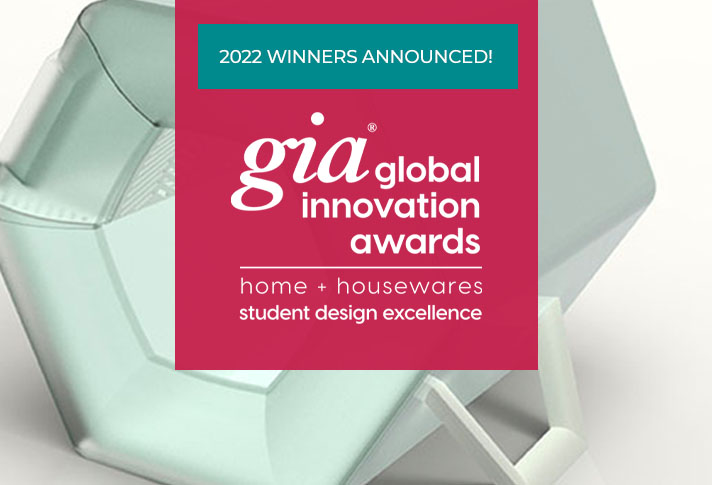Winners in IHA’s 2022 gia Student Design Competition Create Product Concepts that Encourage User Interaction, Serve Consumer Needs and Reduce Waste
The competition challenges college students to redesign a current housewares product to meet the needs of the future or to create a concept for a new product. Winning projects are selected for their innovation, understanding of production and marketing principles, and quality of entry materials.
The winning students and their products will be on display during The Inspired Home Show, IHA’s global home + housewares marketplace, March 5-7 at Chicago’s McCormick Place, the first in-person gathering of the industry’s premier marketplace since 2019.
View the winners and their products on the GIA student design webpage.
Madeline Gerst, a WWU junior from Seattle, Wash., captured first place and $3,500 for her WAVE UV-C Breadbox. Joining her are two second- and three third-place winners who will share $7,000 in prize money. The top six finishers will receive an all-expense paid trip to Chicago for The Inspired Home Show. The three winning schools will receive grants totaling $3,000.
“Madeline’s winning entry is thoughtful, purposeful, user-centered design at its best,” said competition judge Chris Cunningham, IDSA, Cunningham Design, Chicago. “The WAVE UV-C Breadbox reinvigorates a stagnant market/category to meet today’s user needs with a clever application of new technology to refresh a historically low-tech solution. Her product concept is incredibly on trend now with the rise in home bread baking and I can see a manufacturer partnering with her and bringing it to market.”
Globally, almost 900,000 tons of bread, or around 24 million slices each day, are wasted annually, mostly due to an inherently short shelf life and poor storage conditions. Gerst’s winning product concept, WAVE, uses germicidal UV-C light to sterilize pathogens on the surface of bread, significantly extending its shelf life and eliminating the need for harsh chemical preservatives and single-use plastic packaging.
IHA received entries from 26 schools in the U.S., Canada, Austria, Mexico and Romania. Vicki Matranga, IHA’s design programs coordinator and manager of the Student Design Competition, said, “IHA’s program has become known as the gold standard for college-level competitions. Many U.S. professors – and an increasing number internationally – assign the program annually to industrial design students because it is a real-world exercise and every entry receives feedback from two industry professionals. Students must identify user needs and opportunity spaces in the marketplace, research competitive available products, test models with users and consider production issues.”
Second and Third Place Winners
Second-place awards of $2,300 each went to: Rose Kirby, a WWU junior from Seattle, for her Osmo Evaporative Refrigerator; and Nikolaus Potapow, a graduate of FH Joanneum University of Applied Sciences in Graz, Austria, for his RUFUS User Relationship for Extending Appliance Life.
Osmo is a countertop evaporative refrigerator that uses only the power of water to keep fresh foods cool and healthy. Most fruits and vegetables should be stored in a cool and humid environment. The fridge is often too dry, the counter too warm. The first-in, last-out design of conventional refrigerators invites waste, while Osmo helps keep foods visible and healthy.
Rufus is a rotary-drive food mixer with several blender attachments that provides a deeper user-product connection. It engages the user to assemble, maintain and repair the mixer to ultimately lengthen the product’s life span and reduce e-waste.
Third-place awards of $1,200 each went to: WWU junior Elliot Quasha from Seattle, for the Tē Immersion Boiler; WWU junior Carson Porter-Keese from Kent, Wash., the Gro Herb Planter and Western Michigan University junior Isabella Waite from Morley, Mich., for Pip the Potty Pal.
Tē is a portable alternative to an electric kettle that allows the user to heat water for tea or reheat beverages with a portable immersion boiler. Pip the Potty Pal solves two main problems: children not wanting to take breaks from playing to go potty, and parents, nannies or childcare workers forgetting to remind children to use the bathroom. This product helps adults keep track of their child’s bathroom schedule and makes potty breaks fun for children. Gro is a self-supporting planter system that can efficiently grow herbs upside down to save counter space for kitchen activities. In addition, Gro waters itself by absorbing and using moisture from the atmosphere.
Five Honorable Mentions Awarded
Five projects merited an honorable mention and their designers received $250 cash award:
- Team of Sam Eisenberg, Mary Arevalo, Amberly Dawson, Sean Ostrowski and Kasey Connelly, Virginia Polytechnic Institute and State University juniors, Mosaic Smart Puzzle
- Emily Goergen, Iowa State University senior, Namu Nebulizer
- Mohammad Shadab Naveed, Arizona State University junior, Stoven Camp Stove
- Rinona Metaj and Jaclyn Jamieson, Carleton University seniors, Singing Stovetop Kettle
- Yuanqing Li, Cleveland Institute of Art senior, Mosha Litter Box
Judges Include Seven Previous Winners
This year’s winners were chosen by a respected jury of 14, including designers at consumer and industrial product companies, design consultants, educators and seven former winners. Altogether, judges spent many volunteer hours reviewing the submissions, which consist of written materials, sketches, engineering drawings and photos.
Along with Cunningham, the jury included: Brian Bock, industrial designer, Hamilton Beach Brands, Glen Allen, Va.; 2015 winner Evan Cincotta, head of design, Susteau, New York City; Earle Cramer, principal industrial designer, Newell Brands, Kalamazoo, Mich.; 1995 winner Robert Giacolo, new product development program manager, Transcendia, Franklin Park, Ill..; Carly Hagins, IDSA, associate professor of product design, Western Michigan University, Kalamazoo; 2002 winner Lisa Heim-Yoo, design lead, Nu-Way Industries, Inc., Des Plaines, Ill.; 2010 winner Teddy Lu, creative director, VEO, Chicago; 2018 winner Anastasia Miller, senior industrial designer, Doris Dev, Brooklyn, N.Y.; 1996 winner Jennifer Nemec, Ideation Studio, Chicago; Audra Norvilas, senior design manager, Kimberly-Clark, Chicago; David Richter-O’Connell, IDSA, assistant professor, industrial design, University of Wisconsin-Stout, Menomonie; 2018 winner Brandon Rodriguez, industrial designer, Smart Design, Brooklyn, N.Y.; and Kimberlee Wilkens, director, BDes in industrial design, and assistant professor, industrial design, University of Illinois at Chicago.

